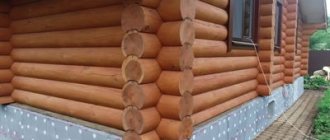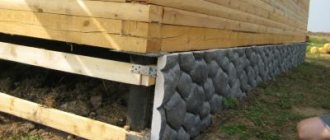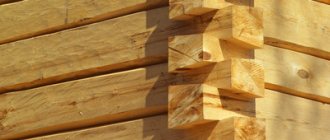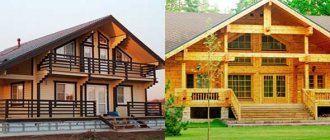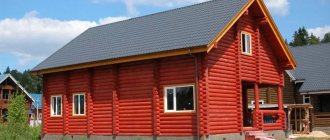A cottage made of wood is a beautiful, warm structure that does not have a negative impact on the surrounding nature. Unfortunately, it is often subject to negative external influences, leading to various destructions.
In this case, the base of residential wooden structures often suffers, so the question of how to strengthen the foundation of a wooden house with your own hands is relevant for residential property owners.
There are many reasons why problems arose with the foundation of a house, ranging from shifting soil layers and the work of heavy special equipment in the neighborhood, to mistakes made during the design and construction of the foundation.
Regardless of the negative factors, it is clearly clear that the damaged foundation of a house requires mandatory restoration.
Narrative plan:
- Common causes of foundation failures;
- Types of foundation destruction;
- Technologies for strengthening the load-bearing base;
- What are the ways to strengthen the base in case of minor damage;
- Strengthening a very deformed, destroyed or old foundation;
- Strengthening the foundation by installing piles;
- Strengthening the support of the house with waterproofing.
Some top tips for restoring your foundation
To determine the rate and degree of subsidence of the base, it is advisable to seal the cracks with paper tape (beacon). The date of recording should definitely be noted on it. If the beacons are torn regularly, almost immediately after the sticker, then this indicates that the process of destruction has entered the active phase, and therefore urgent measures need to be taken to save the building from destruction.
By following certain recommendations, you can carry out repairs on your own.
A large trench is dug right next to the old foundation, encircling the perimeter of the house.
The width of the pit varies from 30 to 40 cm. The depth should be comparable to the first base (its lower edge). A metal pipe (1.5-2 cm in diameter) or some other fittings is placed inside.
The resulting pit is filled with a solution of liquid concrete. The pouring process continues until the solution stops decreasing. This is evidence that the soil no longer absorbs liquid.
The procedure is repeated after two days. The entire network of cracks is again glued with paper beacons. Their integrity indicates that the measures taken were not in vain.
Recessed drainage system
Such drainage on the site is arranged using more complex technology. Clay soils are drained by installing a wall drainage system. On looser soils—crushed stone or sandy soils—a ring network is installed.
In both of these cases, when installing the system on the site, trenches are first dug. Next, the pipes themselves are laid in them. When arranging a wall system, a trench is dripped in close proximity to the foundation. When installing a ring network, excavation work is carried out at a distance of 1.5-3 meters from the base of the house.
The depth of the trenches is chosen so that the pipes are subsequently located below the level of the base of the foundation. When laying outflow lines, maintain a slope away from the house of approximately 2 cm per 1 linear meter.
When constructing a drainage system, special pipes are used. Typically, in suburban areas, when installing a drainage system, corrugated perforated lines are laid.
When arranging a drainage network, among other things, inspection wells are also provided. They are installed at the corners of the building, as well as at pipe junctions. Reception wells are also provided to collect drained water.
The nuances of preparing concrete mixture
The concrete used can be purchased ready-made in retail stores, or you can make the mixture yourself. To do this you should stock up:
- sand; water; cement; plasticizer; crushed stone
At the first stage, equal parts of cement and water are taken. After this, the suspension is replenished with a plasticizer (100 g of mixture per 15 liters of liquid). A triple dose of sand and gravel is added there.
Adding a plasticizer adds plasticity to the solution. Possessing such qualities, the old and new foundations become one. Since excess moisture is removed here, the latter will not freeze out during winter frosts.
Stages of strengthening new foundations under country wooden houses
There are cases when new buildings also need similar repairs (or the load on the future foundation is calculated incorrectly). The same situation occurs when additional extensions to several structures are planned.
Therefore, it is necessary to strengthen the foundation. This is done this way:
- around the building you need to dig a not very deep trench (about 30 cm), inside which a wooden formwork is built from boards; a series of holes are made in the walls of the old foundation using a hammer drill, which are filled with metal pins; A metal wire is stretched between them. The connections are tacked by welding; A concrete solution (consisting of cement, sand, water and filler, ─ crushed stone or gravel) is poured into the reinforced pit.
Foundation strengthening scheme
The resulting reinforced concrete foundation ring takes on a significant share of the total load, which is evenly distributed throughout the area where the building is located. If, in this way, the bearing capacity of the old foundation is strengthened, then the destruction of the latter (or its sediment) is prevented.
This technique is used when the foundation is falling apart along the entire perimeter.
If part of the base deteriorates, then only one side, the “emergency” side, is repaired. Columnar structures are also restored using a similar technique. However, here each pillar is strengthened separately.
About strengthening an outdated foundation using screw piles
In the classic version, the repair of concrete foundations (especially columnar ones) of private houses is carried out by installing screw piles. They cope well with huge loads.
At the same time, their cost is significantly lower in comparison with other types of foundations. A set of mounting screw piles is installed into the base of buildings without any problems (there is no need to use special tools and equipment). Thanks to this, the operational life of the foundation increases to hundreds of years, and the load-bearing characteristics are preserved.
Using screw piles to strengthen the foundation
The process is carried out as follows: screw piles are screwed into the ground at certain intervals. The type of products used is determined by the weight of the future building. After raising the house, you can begin dismantling the outdated foundation.
When reinforcing the foundation with screw piles, you should remember where the load-bearing walls are located and the internal partitions intersect. Experience shows that in these areas it is necessary to strengthen the foundation. Using a special lever, you should screw the piles to the maximum depth, greater than the freezing level.
All piles must rise above the ground surface at the same height.
Its value is controlled by the building level. At the last stage, the piles are connected together, forming a single, durable structure. This option is especially effective where there is constant soil subsidence.
Cementation
The methods described above are technologically complex and expensive. If the foundation does not require too much strengthening, it can be strengthened using a cheaper technique called cementation. In this case, holes leading under the foundation are first drilled on the soil surface.
Next, concrete is pumped under pressure under the base. This method of strengthening foundations is often used, for example, on heaving and other types of unstable soils. This technology can be used to strengthen the foundations of buildings up to 2 floors high.
How to strengthen the base with waterproofing
The service life of wooden building foundations can be significantly increased if possible threatening and dangerous situations are prevented. In particular, an effective preventive measure is the procedure of waterproofing the base. It should be carried out even when a trench is being dug around the outer walls of country houses.
Strengthening the base with waterproofing
The walls of the base are treated with a solution of hot bitumen, on top of which foam sheets are glued. This design will not only protect the foundation from moisture penetration, but will also increase the frost resistance of the foundation.
If the basement begins to get damp, then it is worth carefully insulating the internal space of the latter.
Here, too, you should dig up the ground. Then the foundation walls are covered with roofing felt or roofing felt (at least 3 layers). Adjacent layers are reliably bonded with heated bitumen.
To strengthen the foundation, one side is divided into 2-meter sections.
Then you should begin to strengthen the structure. A trench is again dug next to the old structure. In depth it should exceed the level of the former foundation.
The walls of the old structure are covered with a system of holes for reinforcement, which will serve as a connecting link between the old and new foundations. Upon completion of assembly, the section is filled with concrete. The next section can only be processed after the previous segment has completely dried.
What causes the foundation to collapse?
You will have to correct the negative consequences of external factors on the foundation under the house, but what if you have never had to do foundation repairs yourself in your life? To understand which strengthening of the foundation of a building is preferable, you should understand the reason for its collapse. There are two explanations why pieces of the foundation suddenly begin to fall off and the foundation itself crumble: technology violations during construction or external negative factors (soil displacement, changes in its composition, groundwater movement, vibration).
Collapse of the foundation of the building
The first reason may include improper preparation of the binder mortar, poor-quality building materials, incorrect measurements, which led to misalignment of the masonry. The second “critical point” may be that during construction the composition of the soil, its moisture content were not taken into account, or the drainage was carried out incorrectly.
To determine whether the destruction of the foundation under the house continues and whether it needs to be strengthened urgently, paper tapes should be glued to the detected cracks. If they are not torn apart within a week, then the splits will not expand.
You can use plaster tapes. In addition to visual inspection, soil samples are taken, including to determine its chemical composition. Thanks to this analysis, it is possible to select building materials that are not affected by external factors or their harmful effects are minimal.
Prevention of foundation construction
Like any structure, the foundation needs mandatory preventive procedures. Thanks to them, you can significantly extend the life of a private home and delay strengthening and putting it in proper order. It is recommended to pay attention to the following “pain points”:
- Before building a foundation, be sure to use geodetic and geological services, which will determine whether it is possible to build a residential building on a certain plot of land. In no case deviate from the requirements of technology: do not use a binding solution that does not correspond to the design, bricks with other hygroscopic properties, do not save on the components of the concrete mixture. Do not make changes to the plan of a private house (reconstruction of load-bearing partitions and walls, construction of additional floors and extensions), which may change the application of support points to the foundation and redistribute the weight load of the main building. Do not neglect the construction of a shock-absorbing cushion under foundation, drainage ditches and moisture insulation. For long-term operation of the building, you should not skimp on this work. All communications should be laid before the foundation is erected. The deployment of these measures after construction can lead to improper shrinkage of the entire building, and as a result, to the appearance of cracks and destruction of its foundation.
Conclusion
Remember, the main thing is to promptly notice the destruction of the foundation structure. Check its condition periodically. This way you can save money, energy and time. After all, strengthening an old foundation is much easier than replacing it completely.
A solid foundation is the key to the stability and safe operation of a building. Long-term operation, increased load, and the quality of raw materials can affect the integrity of the base.
Strengthening the foundation with a reinforced concrete jacket will help preserve the house and extend its service life. The proven method is a simple and reliable way to strengthen the strip base. Installation work can be completed without the involvement of specialists.
Strengthening the foundation - an affordable way
Let's start with the most popular, one might say, classic way of strengthening the foundation.
The algorithm of actions has already been worked out for centuries, and therefore is most preferable because of its effectiveness and efficiency, and can be completely implemented with your own hands. The point is to build a new foundation, which is laid out around the house along its perimeter and serves as additional support for laying the old foundation. All work is divided into a number of successive stages.
First, square holes must be dug at each corner of the building in order to expose the masonry of the old foundation. The dimensions of the pit are 1x1 m.
The depth must be 0.5 m below the old base. Then you will need to make frames from reinforcement according to the number of corners of the building or along the length of the walls, if you decide to reinforce the entire perimeter. Then comes the installation of structures made of metal rods into the resulting recesses and the filling of square holes with reinforcement with concrete, the grade of which guarantees the special strength of the material.
Strengthening the foundation with a structure made of metal rods
It is recommended to prepare the reinforcement frame in advance.
The recommended cell size is 20x20x20 cm. This is the maximum. If it is possible to make a smaller structure, then this will only be beneficial.
The work is quite scrupulous - exposing the old foundation for too long can lead to negative effects of the external environment and subsequent distortion.
That is why it is recommended to divide the pouring perimeter into sections not exceeding a length of 2 m. The next sector will be strengthened after the concrete in the previous one has “set” completely. For the same reason, it is recommended to expose the corner parts of the foundation as it is poured, so that the exposure time is minimal.
Use of shotcrete
Shotcrete is used for brick buildings equipped with a basement. The use of a concrete composition with drilling of the surface makes it possible to strengthen the foundation of a brick house with a basement. The technical technique restores weakened load-bearing walls, strengthens the structure and increases its resistance to a humid environment. To complete the task you need:
- Study the features of the base of the building, detect minor errors and localize them.
- Dig a trench line, widening it by 2 m and exposing the masonry.
- Clean the structure from cladding, debris, and wet soil.
- Use a hammer drill to make holes to a depth below the base, which will improve the adhesion of concrete and monolith.
- Install a steel frame made of reinforcement with a diameter of 8-14 mm.
- Pour liquid concrete into the holes and level it thoroughly.
Shotcrete is a technique that requires financial costs and construction skills. An alternative for doing the tasks yourself would be cementing - it helps strengthen brick buildings on heaving plastic soils.
Strengthening the foundation of a wooden house
If the first method can be done with your own hands even by a single person, then for a wooden house it is a little more difficult to organize the strengthening of the foundation. The fact is that the most common problem with such buildings is rotting of the crown, that is, decay of the lower logs of the log house. For everything to go well, it is necessary to replace this part of the hut; at the same time, you can use the opportunity to lay waterproofing material.
It should be noted that the operation to replace the crown should precede the strengthening of the base. First, a small dismantling of the foundation is done under the lower log in order to freely remove the rotten wood. At the junctions with other logs it is necessary to make cuts.
Afterwards, part of the dismantled foundation is restored.
When the entire procedure is done, the same is done on the opposite side of the house. Having finished with one row around the perimeter, you can begin replacing the next one. It should be noted that the crown of a wooden house is made up of two rows of logs, and when replaced, each one must be impregnated with special compounds and covered with a waterproofing agent.
But what to do if not only the logs have failed, but also the old foundation has collapsed in several places, and serious work is needed to restore it? Here you can’t do without hydraulic devices. Remove the load on the foundation, i.e.
e. remove heavy furniture and equipment from the premises. It is also advisable to dismantle the doors and floor.
Along the entire perimeter of the building, every 2 m it is necessary to prepare holes into which channels or I-beams should be inserted; they will act as a platform. With the help of hydraulic jacks, these iron structures evenly lift the house to a height that allows strengthening the foundation itself.
Temporary supports (welded structures or wooden blocks) are installed under the house. When full access to the foundation is obtained, reinforcement can be fully carried out. Having finished the work, you just need to put the house in place and bring in all the things.
Surface drainage system
If the soil on the property is wet, in some cases the foundation can be strengthened simply by draining the yard. Making a drainage system on the site with your own hands will not be too difficult. Such a drainage network can be either surface or buried.
When arranging a drainage network of any type, the terrain features of the site must be taken into account. Usually, owners of country plots simply wait for heavy rain, and then watch exactly how the water flows along the ground. The pipes are subsequently laid in accordance with the identified slopes.
The first type of drainage is arranged on the site as follows:
- pits are dug under storm drains next to the foundation and storm water inlets are installed in them;
- dig diversion trenches;
- strengthen the bottom and walls of trenches by concreting or laying pipes cut into two halves along the length.
Features of repair depending on the type of foundation
But what about the types of the foundation itself, since most often it is columnar and strip?
Will their strengthening take place in some specific way? Many people know that columnar is a system of piles (pillars) that are installed in places of maximum load. To properly distribute the load on these supports, various devices such as grillages and strapping beams are used.
The design of the tape is also intuitively clear from the name. This is a reinforced concrete structure in the form of a closed loop. Columnar is often combined with ribbon.
Reinforced strip foundation
If you want to deploy reinforcement to any of these designs, then both methods described above will work for this. In addition, the columnar base can be improved by drilling holes in the pillars and providing them with reinforced rods. How to strengthen a strip-type foundation, you can even choose from several options: by replacing parts with new ones (block), or by erecting formwork and pouring a layer of concrete (monolithic).
- Author: Mikhail MalofeevPrint
A wooden house is beautiful, warm and environmentally friendly. But, unfortunately, it is short-lived. The causes of destruction are different.
Let's dwell on how to strengthen the foundation of an old wooden house with your own hands. The reasons for foundation damage are different: shifting soil layers, the operation of heavy equipment close to the house, incorrect initial construction. Whatever the reasons, one thing is clear - the foundation must be restored.
Causes and types of foundation destruction
When starting to strengthen the foundation of an old wooden house with your own hands, you first need to correctly determine the cause of its deformation.
Destroyed foundation of a wooden house
There can be several factors for the occurrence of destruction:
Due to changes in load, soil properties may change. Such changes are caused by soil erosion and high groundwater levels. If new buildings appear near the house, this can also lead to certain changes.
The buildings seem to squeeze out the soil and thereby violate its density. The consequence of all this is subsidence of the house or its warping. Poor quality of the initial construction of the foundation. When laying the foundation, the work may have been performed poorly, errors were made in calculating the depth of soil freezing or in choosing the grade of concrete.
Determining the cause of structural deformation is only the initial stage. The next stage is determining the extent of destruction. They are divided into four types:
Minimal damage is visible defects.
These include slightly peeling plaster. This damage is repaired very quickly. Moderate damage. These include different types of cracks.
To eliminate defects, their nature should be investigated. Horizontal cracks are not particularly dangerous. Defects of a vertical or zigzag nature deserve more serious consideration.
Cracks usually occur due to subsidence of the foundation. Therefore, it is important to determine whether this process is progressing or is temporary.
Beacons for monitoring foundation destructionThe depth can be determined by applying beacons.
In places of cracks, a beacon of gypsum putty is applied - a horizontal line 0.5 cm thick. The slightest movement will damage the integrity of the putty. Next, we follow the beacon.
If it remains intact, then the subsidence is temporary. In this case, minor repairs of cracks are performed. If the beacons are broken, then eliminating the cracks will not save the situation.
It is necessary to strengthen the supporting structure. Catastrophic deformations lead to the fact that the house can be completely destroyed. In this case, it is urgent to carry out work to thoroughly strengthen the foundation. Irreparable damage. In case of such damage, it is necessary to completely replace the supporting structure.
Technologies for strengthening the foundation of an old wooden house
Depending on the degree of destruction of the foundation of the old house, certain work is carried out to strengthen it. The simplest and easiest to do with your own hands is to seal cracks, which usually occur when the house subsides slightly.
To do this, you need to slightly widen the crack and clean it of dirt. Then prime it well and seal it with sand-cement mortar. Also, partial repairs to the support of the house can be performed if the building has sunk into the ground.
Lifting the house
To do this, the structure rises. To perform this procedure, first of all we reduce the load on the base. It is necessary to remove all furniture from the house, dismantle the floor and remove the stove if it does not have its own foundation.
If the house is small and light, then you can lift it with the help of a wagon. To do this, a wooden beam with a cross-section of 80×80 mm is placed at the corner of the building. Then they use the wagons as a lever, focusing on the log, and raise the house.
Heavier houses are lifted using a jack, which is placed in certain places.
After the building has been raised to the desired height, the old foundation of the house should be built up using brick or concrete. For more serious foundation deformations, one side of the foundation is usually strengthened or, if necessary, the entire perimeter. Let's consider several types of strengthening the supporting structure.
Strengthening the foundation - priority actions
The types of work that will need to be performed depend on what kind of material and what technology was used to initially form the basis of the building. It is impossible to independently repair the foundation of an old wooden house using a universal method - the approach to repair must be based on knowledge of the type of foundation. As a rule, the foundations of such buildings in Russia are of two types, depending on their external shape - either columnar or strip. These types of foundations were most often used for relatively old buildings.
In addition, it is necessary to decide whether a complete reconstruction of the base part of the structure should be carried out or whether it is sufficient to strengthen the supports of a columnar foundation that has completely fallen into disrepair. It should be noted that improving or replacing a strip foundation is a much more labor-intensive process. It may be enough to just plaster some cracks with cement; however, soil deformation means that the foundation of the building will have to be completely or partially replaced. It is also possible to simply strengthen the foundation, but this repair option is directly related to the level of damage.
Deterioration in the quality of the house foundation
When preparing to repair a foundation yourself, you should perform the following preliminary steps:
- turn off electricity, gas, and other communications that may be damaged;
- remove all heavy things and furniture;
- dismantle the flooring;
- remove the stove, if there is one in the house (however, in the case of a personal foundation, it is allowed to leave it in place).
When lifting a house, standard light- and medium-duty truck jacks, both hydraulic and mechanical, are used.
After the preliminary work to prepare for the repair has been completed, it is important to take the following actions responsibly:
- If the house has a columnar foundation, it is necessary to prepare in advance a platform from downed wood, where a device for raising the wooden house will be installed.
- The house should be lifted from the corner, as if “hooking” it.
- It is necessary to determine that part of the crown that will take on the maximum force of the tool (jack); the steel transmitting this force cannot be thinner than 5 mm.
- Bricks are removed from the base of the building in order to remove part of the backfill, or a block of strip foundation is punched out. These actions are carried out to preserve the lower crown of the building.
- Driven longitudinal boards are successfully used, which are directed vertically into pre-prepared logs - it is safer to raise an old house this way, since the structure is additionally protected.
Repairing the foundation by strengthening the corners
Sometimes, to strengthen the supporting structure of a wooden house, they limit themselves to strengthening the corners.
In order to do this work correctly, you must first expose the corners of the base. To do this, a hole is dug near each corner of the house, the diameter of which is about a meter.
The depth of the hole should be half a meter lower than the depth of the old foundation. Reinforcement is carried out using a reinforcing lattice. The cell dimensions are 20x20 cm.
Strengthening foundation corners
On the old foundation, the reinforcement is cleared of concrete in some places, to which a reinforcing lattice is attached. In this case, the connection should be made by welding.
After the grate is installed, they begin pouring concrete layer by layer and leave it to harden. In order to increase the degree of reinforcement, you can strengthen not only the corners. In some places, ditches up to half a meter wide are prepared along the perimeter of the dwelling every one and a half or two meters.
The depth of the ditches is equal to the depth of the old support.
Then reinforcing bars are attached to the steel rods of the old base and filled with concrete again. Thus, reinforcement occurs both in the corners and around the entire perimeter. This is easy to do with your own hands and significantly increases the bearing capacity of the foundation.
Concrete must be poured gradually in layers. This can be achieved by filling the recesses one at a time.
Introduction of drilled injection piles
This is the most advanced and modern way to strengthen the foundation of a country brick house.
The old foundation is drilled from both sides until solid soil is found. Wells must be made at an angle. The diameter of the wells should reach 25 centimeters. The depth is individual in each case.
Cement is poured into the resulting wells. After which a frame made of reinforcement is mounted there. After the concrete solution has completely hardened, the house will stand on many reliable and strong piles. The amount depends only on the type of soil and the condition of the old foundation.
This is the most popular and modern method in the construction market. Its only drawback is the need to use special equipment. This work cannot be carried out without the necessary machines.
Strengthening the base with an armored belt
A frequently used and reliable way to strengthen a foundation with your own hands is to install a monolithic reinforcing belt around the old base. Watch the video on how to strengthen the base with an armored belt.
To construct it, a certain algorithm is used:
Prepare a trench around the house. It must be such that there is free access to the base and the possibility of unhindered work. Its width can be 50–60 cm.
The depth should be at least 0.6 meters below the old support. For better adhesion of the old base and the reinforcing belt, the foundation walls are thoroughly cleaned of foreign objects. It should be cleaned thoroughly; it is best to use a metal brush. Next, deep priming is carried out. A sand and gravel cushion is poured onto the bottom of the trench, which is well shed and compacted.
It should be fairly well compacted. Formwork is mounted from boards or plywood. We prepare holes in the old foundation with a diameter larger than the cross-section of the reinforcing bars by one millimeter. It is best to use reinforcement with a diametrical cross-section of 12 mm or 14 mm. We install steel rods by driving them into the prepared holes.
The distance between them should be 25–30 cm. It is better to arrange the rods in several rows. A new reinforcing belt or reinforcing mesh is attached to the clogged rods. Proceed with layer-by-layer pouring of concrete. The thickness of the layers should not exceed 20 cm. Waterproof the reinforcing belt and arrange a blind area.
Strengthening the supporting structure in this way allows you to evenly distribute the load over a double area.


